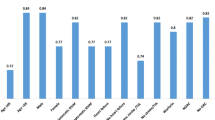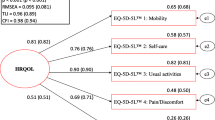Abstract
Objectives
Since few studies have investigated Health related Quality of Life (HRQoL) in older patients with atrial fibrillation, the aim of this cross-sectional study was to compare HRQoL in AF elderly inpatients of 65 and more with that of age-matched controlled subjects.
Design
HRQoL was assessed with two generic HRQoL instruments: the MOS-SF 36, a largely recognized instrument, and the Duke Health Profile.
Setting and patients
Nancy University Hospital patients presenting with atrial fibrillation and three controls per patient free of cardiac arrhythmias, matched by age, sex and hospital department to atrial fibrillation patients.
Results
Forty one atrial fibrillation patients and 123 controls were included. Both groups were comparable for associated disorders, other than coronary artery disease and chronic respiratory failure. After adjustment, scores among atrial fibrillation patients were lower than among controls in 8 of 10 Duke and 6 of 8 SF-36 subscales. In terms of Quality of Life, meaningful differences (≥5 points) were recorded in the Duke: Mental, Depression, Anxiety, General Score; and in the SF-36: Physical functioning, Role emotional, Social functioning and Vitality. Nevertheless statistically significant differences were only observed for the Duke Mental (p=0.01), Depression (p=0.003) and Anxiety (p=0.03) scores.
Conclusions
In our study HRQoL measured in elderly inpatients with atrial fibrillation as compared with matched controlled was mainly altered in the “psychological” domains of the Duke Health Profile. From the patient’s point of view, atrial fibrillation appears to have more mental than physical consequences. This study pointed out the utility to assess HRQoL in the management and treatment of elderly hospitalised atrial fibrillation patients.
Similar content being viewed by others
Abbreviations
- AF patients:
-
patients with atrial fibrillation
- HRQoL:
-
Health related Quality of Life
- CQV:
-
CliniQualVie study
- OAT:
-
Oral Anticoagulant Treatment
- SF-36:
-
MOS SF-36 questionnaire
- Duke:
-
Duke Health Profile questionnaire
References
Kannel WB, Abbott RD, Savage DD, McNamara PM. Epidemiologic features of chronic atrial fibrillation: the Framingham study. N Engl J Med. 1982;306:1018–1022.
Wolf PA, Abbott RD, Kannel WB. Atrial fibrillation: a major contributor to stroke in the elderly. The Framingham Study. Arch Intern Med. 1987;147:1561–1564.
Snow V, Weiss KB, LeFevre M et al. Management of newly detected atrial fibrillation: a clinical practice guideline from the American Academy of Family Physicians and the American College of Physicians. Ann Intern Med. 2003;139:1009–1017.
Perret-Guillaume C, Wahl D. Low-dose warfarin in atrial fibrillation leads to more thromboembolic events without reducing major bleeding when compared to adjusteddose—a meta-analysis. Thromb Haemost. 2004;91:394–402.
Luderitz B, Jung W. Quality of life in patients with atrial fibrillation. Arch Intern Med. 2000;160:1749–1757.
Lane DA, Lip GY. Quality of life in older people with atrial fibrillation. J Interv Card Electrophysiol. 2009 Jun;25(1):37–42.
Kale M, Bennett DH: Pacemaker prevention therapies for the control of drug-refractory paroxysmal atrial fibrillation. Europace 2003;5:123–131.
Pappone C, Rosanio S, Augello G et al. Mortality, morbidity, and quality of life after circumferential pulmonary vein ablation for atrial fibrillation: outcomes from a controlled nonrandomized long-term study. J Am Coll Cardiol. 2003;42:185–197.
Twidale N, Manda V, Nave K, Seal A. Predictors of outcome after radiofrequency catheter ablation of the atrioventricular node for atrial fibrillation and congestive heart failure. Am Heart J. 1998;136:647–657.
Weerasooriya R, Davis M, Powell A et al. The Australian Intervention Randomized Control of Rate in Atrial Fibrillation Trial (AIRCRAFT). J Am Coll Cardiol. 2003;41:1697–1702.
Brignole M, Menozzi C, Gasparini M et al. An evaluation of the strategy of maintenance of sinus rhythm by antiarrhythmic drug therapy after ablation and pacing therapy in patients with paroxysmal atrial fibrillation. Eur Heart J. 2002;23:892–900.
Channer KS, Birchall A, Steeds RP et al. A randomized placebo-controlled trial of pre-treatment and short- or long-term maintenance therapy with amiodarone supporting DC cardioversion for persistent atrial fibrillation. Eur Heart J. 2004;25:144–150.
Gronefeld GC, Lilienthal J, Kuck KH, Hohnloser SH. Impact of rate versus rhythm control on quality of life in patients with persistent atrial fibrillation. Results from a prospective randomized study. Eur Heart J. 2003;24:1430–1436.
Lancaster TR, Singer DE, Sheehan MA et al. The impact of long-term warfarin therapy on quality of life. Evidence from a randomized trial. Boston Area Anticoagulation Trial for Atrial Fibrillation Investigators. Arch Intern Med. 1991;151:1944–1949.
Bubien RS, Knotts-Dolson SM, Plumb VJ, Kay GN. Effect of radiofrequency catheter ablation on health-related quality of life and activities of daily living in patients with recurrent arrhythmias. Circulation 1996;94:1585–1591.
Dorian P, Jung W, Newman D et al. The impairment of health-related quality of life in patients with intermittent atrial fibrillation: implications for the assessment of investigational therapy. J Am Coll Cardiol. 2000;36:1303–1309.
Hagens VE, Ranchor AV, Van SE et al. Effect of rate or rhythm control on quality of life in persistent atrial fibrillation. Results from the Rate Control Versus Electrical Cardioversion (RACE) Study. J Am Coll Cardiol. 2004;43:241–247.
Howes CJ, Reid MC, Brandt C et al. Exercise tolerance and quality of life in elderly patients with chronic atrial fibrillation. J Cardiovasc Pharmacol Ther. 2001;6:23–29.
Lonnerholm S, Blomstrom P, Nilsson L, Oxelbark S, Jideus L, Blomstrom-Lundqvist C. Effects of the maze operation on health-related quality of life in patients with atrial fibrillation. Circulation 2000;101: 2607–2611.
van den Berg MP, Hassink RJ, Tuinenburg AE et al. Quality of life in patients with paroxysmal atrial fibrillation and its predictors: importance of the autonomic nervous system. Eur Heart J. 2001;22:247–253.
Briançon S, Gergonne B, Guillemin F, Empereur F, Klein S. Disease-specific versus generic measurement of Health Related Quality of Life in cross-sectional and longitudinal studies: an inpatient investigation of the SF-36 and four disease-specific instruments. In: Mesbah M, Cole BF, Ting Lee ML. Statistical methods for quality of life studies. Design, measurements and analysis. Dordrecht: Kluwer; 2002:87–100.
Ware JE, Jr., Sherbourne CD. The MOS 36-item short-form health survey (SF-36). I. Conceptual framework and item selection. Med Care 1992;30:473–483.
Parkerson GR, Jr., Broadhead WE, Tse CK. The Duke Health Profile. A 17-item measure of health and dysfunction. Med Care 1990;28:1056–1072.
Leplege A, Ecosse E, Verdier A, Perneger TV. The French SF-36 Health Survey: translation, cultural adaptation and preliminary psychometric evaluation. J Clin Epidemiol. 1998;51:1013–23.
Guillemin F, Paul-Dauphin A, Virion JM, Bouchet C, Briancon S. [The DUKE health profile: a generic instrument to measure the quality of life tied to health]. Sante Publique 1997;9:35–44. -42.
McHorney CA, Ware JE Jr, Lu JF, Sherbourne CD. The MOS 36-item Short-Form Health Survey (SF-36): III. Tests of data quality, scaling assumptions, and reliability across diverse patient groups. Med Care;32:40–66.
Kang Y, Bahler R. Health-related quality of life in patients newly diagnosed with atrial fibrillation. Eur J Cardiovasc Nurs. 2004;3:71–6.
Benjamin EJ, Levy D, Vaziri SM, D’Agostino RB, Belanger AJ, Wolf PA. Independent risk factors for atrial fibrillation in a population-based cohort. The Framingham Heart Study. JAMA. 1994;271:840–4
Tapson VF, Hyers TM, Waldo AL, et al. Antithrombotic therapy practices in US hospitals in an era of practice guidelines. Arch Intern Med. 2005 165:1458–64
Hays RD, Woolley JM. The concept of clinically meaningful difference in healthrelated quality-of-life research. How meaningful is it? Pharmacoeconomics. 2000 Nov;18(5):419–23.
Samsa G, Edelman D, Rothman ML, Williams R, Lipscomb J, Matchar D. Determining clinically important differences in helath status measures. A general approach with illustration to the Health Utilities Index Mark II. Pharmacoeconomics 1999;15:141–55.
Nemeroff CB. The curiously strong relationship between cardiovascular disease and depression in the elderly. Am J Geriatr Psychiatry. 2008;16:857–60.
Author information
Authors and Affiliations
Corresponding author
Rights and permissions
About this article
Cite this article
Perret-Guillaume, C., Briancon, S., Wahl, D. et al. Quality of life in elderly inpatients with atrial fibrillation as compared with controlled subjects. J Nutr Health Aging 14, 161–166 (2010). https://doi.org/10.1007/s12603-009-0188-5
Received:
Accepted:
Published:
Issue Date:
DOI: https://doi.org/10.1007/s12603-009-0188-5




